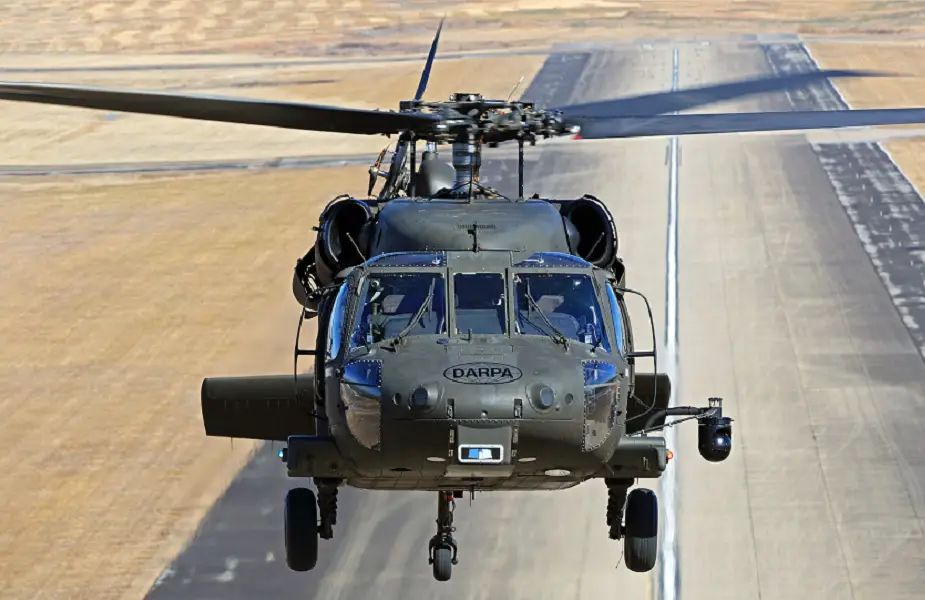Breaking news
Black Hawk helicopter completes first unmanned flight.
The DARPA Aircrew Labor In-Cockpit Automation System (ALIAS) program completed a first ever flight of a UH-60A Black Hawk helicopter without anyone onboard. Sikorsky, a Lockheed Martin company, completed 30-minutes of uninhabited flight with the optionally piloted vehicle (OPV) over the U.S. Army installation at Fort Campbell, Kentucky on February 5th. An additional uninhabited flight was also conducted on February 7th.
Follow Air Recognition on Google News at this link
 This historic BLACK HAWK flight marks the first time that a UH-60 has flown autonomously and builds on recent demonstrations at the U.S. Army’s Project Convergence 2021 (Picture source: Lockheed Martin)
This historic BLACK HAWK flight marks the first time that a UH-60 has flown autonomously and builds on recent demonstrations at the U.S. Army’s Project Convergence 2021 (Picture source: Lockheed Martin)
On a clear and cold morning, the autonomous BLACK HAWK, equipped with ALIAS (Aircrew Labor In-Cockpit Automation System) begins executing a 30-minute mission. To demonstrate its ability to adapt to a variety of mission environments, the uninhabited BLACK HAWK navigates at typical speed and altitude through a simulated cityscape, avoiding imagined buildings while route re-planning in real time. All the while, on-board sensor simulation provides real-time obstacle data.
The BLACK HAWK helicopter then autonomously executes a series of pedal turns, maneuvers and straightaways before completing a perfect landing. Once it shuts itself down, the two pilots approach and re-enter the aircraft. The OPV (optionally-piloted vehicle) switch is reversed from zero to two, and then the pilots taxi back down the runway.
This historic BLACK HAWK flight marks the first time that a UH-60 has flown autonomously and builds on recent demonstrations at the U.S. Army’s Project Convergence 2021. It illustrates how ALIAS-enabled aircraft can help soldiers successfully execute complex missions with selectable levels of autonomy – and with increased safety and reliability.
Benjamin Williamson, lead test pilot for the Fort Campbell event, said, “This capability will allow pilots to confidently switch back and forth between autonomy and piloted modes at any point of their mission with the literal flip of a switch. This will support autonomous flight during a wide range of missions such as flight in degraded visual environments (DVE) and confined areas. Most critically, ALIAS will be capable of automatically detecting and preventing dangerous situations that lead to accidents, thereby saving lives.”

The Army is currently exploring potential use cases for technologies such as ALIAS, including those outlined in the U.S. Army’s Future Vertical Lift (FVL) program (Picture source: Lockheed Martin)
ALIAS is a flexible, extensible automation architecture for existing manned aircraft that enables safe reduced crew operations, which facilitates the addition of high levels of automation into existing aircraft. It also provides a platform for integrating additional automation or autonomy capabilities tailored for specific missions.
“With reduced workloads pilots can focus on mission management instead of the mechanics,” said Stuart Young, program manager in DARPA’s Tactical Technology Office. “This unique combination of autonomy software and hardware will make flying both smarter and safer.”
The ALIAS program has leveraged the considerable advances in aircraft automation systems over the past 50 years, as well as similar advances in remotely piloted aircraft. Even in today’s most automated aircraft, pilots must still manage complex interfaces and respond to unexpected situations.
ALIAS aims to support execution of an entire mission from takeoff to landing, including autonomously handling contingency events such as aircraft system failures. Easy-to-use interfaces facilitate supervisor-ALIAS interaction.
 This illustrates how ALIAS-enabled aircraft can help soldiers successfully execute complex missions with selectable levels of autonomy – and with increased safety and reliability (Picture source: Lockheed Martin)
This illustrates how ALIAS-enabled aircraft can help soldiers successfully execute complex missions with selectable levels of autonomy – and with increased safety and reliability (Picture source: Lockheed Martin)
“With ALIAS, the Army will have much more operational flexibility,” said Young. “This includes the ability to operate aircraft at all times of the day or night, with and without pilots, and in a variety of difficult conditions, such as contested, congested, and degraded visual environments.”
The Army is currently exploring potential use cases for technologies such as ALIAS, including those outlined in the U.S. Army’s Future Vertical Lift (FVL) program.
Within the next month, the ALIAS program plans to conduct the first flight of a fly-by-wire M-model Black Hawk at Fort Eustis, Virginia.

























